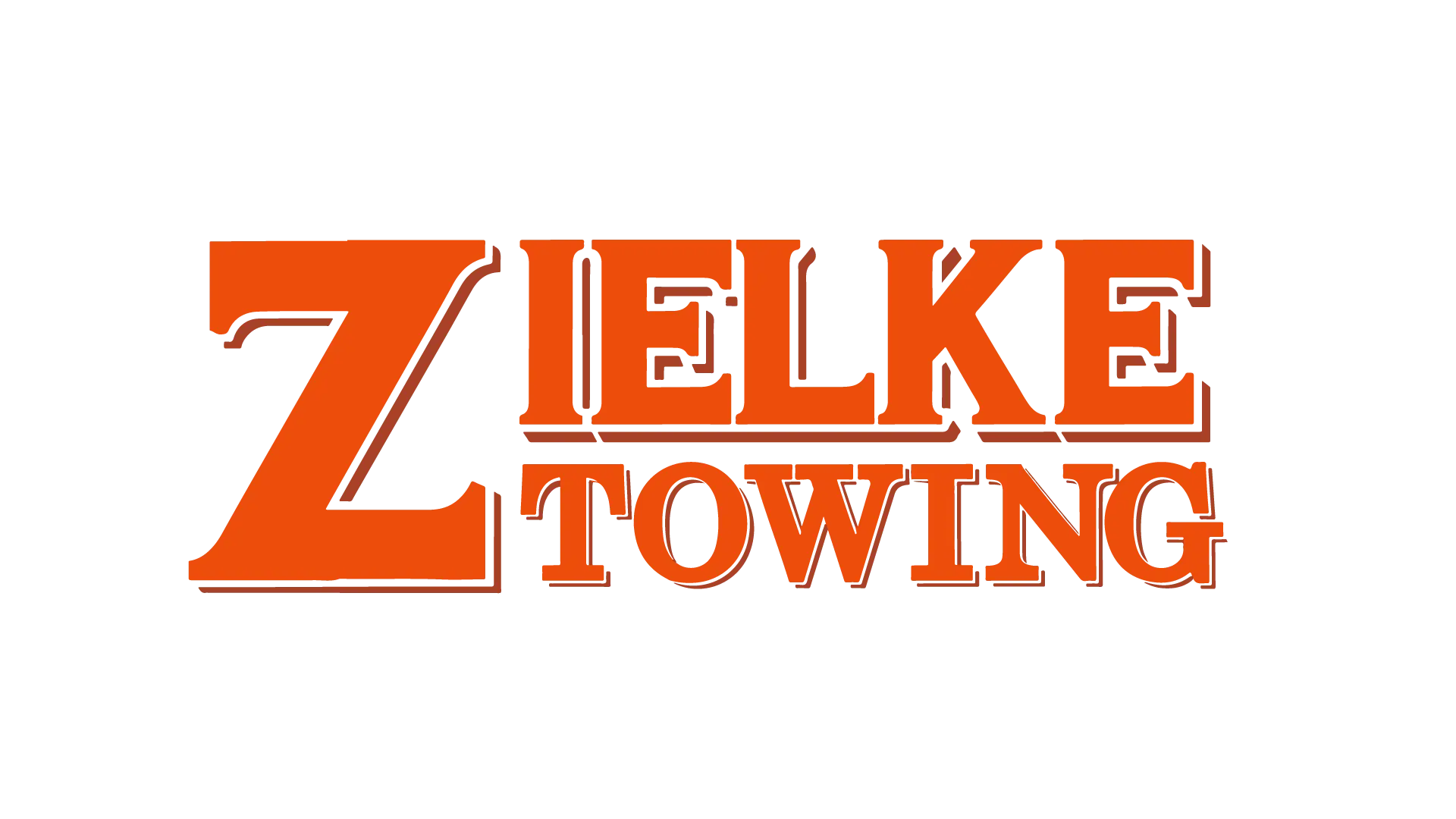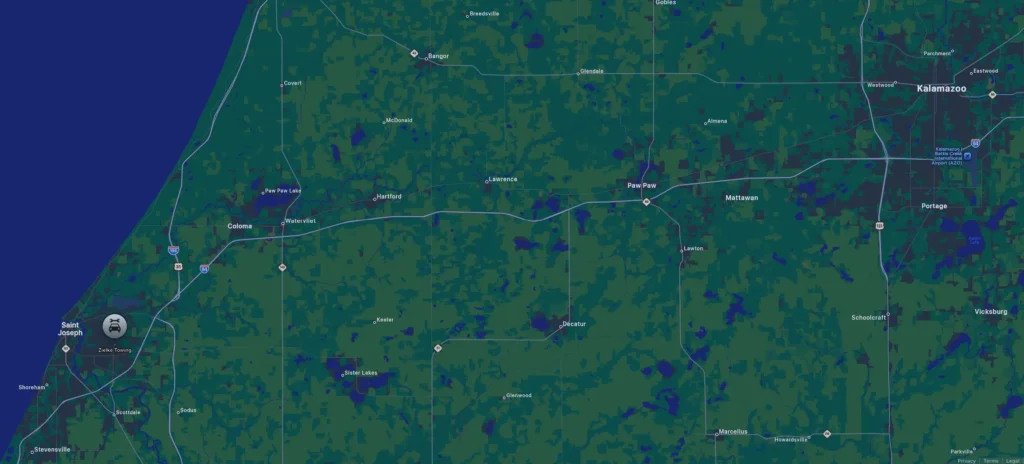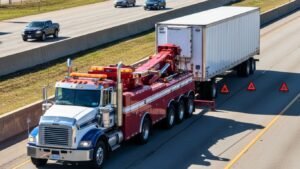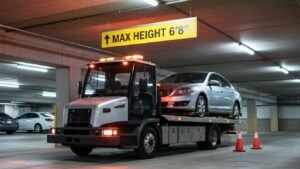The Commercial Driver’s Dilemma
Picture this: Your 18-wheeler breaks down on Interstate 80 during peak traffic hours. Steam pours from under the hood, and you’re blocking the right lane with 80,000 pounds of truck and cargo. You call for help, but the first towing company you reach tells you they can’t handle your rig. Their standard tow truck maxes out at 15,000 pounds – your empty tractor alone weighs twice that.
This scenario highlights a critical reality in commercial trucking: regular tow trucks simply cannot handle heavy-duty vehicles. The equipment, expertise, and protocols required for heavy-duty truck towing operate in an entirely different league from standard automotive recovery services.
Understanding these differences isn’t just useful knowledge – it’s essential for protecting your commercial investment and ensuring safe, compliant recovery operations. Whether you’re a commercial driver, fleet manager, or trucking company owner, knowing what makes heavy-duty towing different can save you thousands of dollars and prevent dangerous recovery attempts.
Drawing from decades of commercial trucking industry expertise and DOT compliance standards, this guide will equip you with the knowledge to handle heavy-duty towing situations confidently and cost-effectively.
Understanding Heavy-Duty vs. Light-Duty Towing
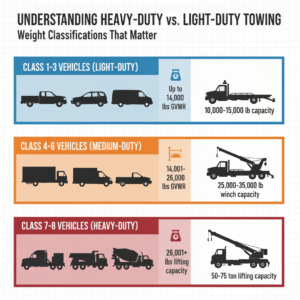
Vehicle weight classifications determine everything about your towing requirements. The federal system breaks down as follows:
Class 1-3 vehicles (light-duty standard towing) include pickup trucks, vans, and SUVs weighing up to 14,000 pounds GVWR. Standard tow trucks with 10,000-15,000 pound capacity handle these easily using wheel-lift or flatbed methods.
Class 4-6 vehicles (medium-duty requirements) encompass delivery trucks, box trucks, and smaller commercial vehicles weighing 14,001-26,000 pounds GVWR. These require medium-duty wreckers with 25,000-35,000 pound winch capacity and reinforced boom systems.
Class 7-8 vehicles (heavy-duty specialized needs) include semi-tractors, large dump trucks, and concrete mixers weighing 26,001+ pounds GVWR. Industry estimates show these vehicles require specialized rotator recovery trucks with 50-75 ton lifting capacity and advanced hydraulic systems.
What class is your commercial vehicle? This single factor determines your entire towing approach, equipment requirements, and cost structure.
Equipment Differences at a Glance
The tonnage capacity requirements jump dramatically between classifications. While a standard tow truck operates with 7-15 ton capacity, heavy-duty truck towing demands 25-75 ton capacity equipment.
Specialized rigging and chains become non-negotiable. Heavy-duty operations require Grade 70, 80, or 100 chains rated for specific weight loads, compared to standard Grade 43 chains used in light-duty towing.
Advanced hydraulic systems power the massive booms, winches, and stabilization equipment needed for commercial vehicle recovery. These systems operate at 3,000+ PSI pressure levels, far exceeding the 1,500-2,000 PSI found in standard tow trucks.
Specialized Equipment for Heavy-Duty Towing
Rotator Recovery Trucks
Rotator tow trucks represent the pinnacle of heavy-duty recovery equipment. These specialized machines provide 50-75 ton lifting capacity through their main boom, with some units reaching 100+ ton capacity for the heaviest commercial applications.
The 360-degree rotation capabilities allow operators to position loads precisely without repositioning the entire truck. This becomes essential when recovering jackknifed semi-trailers or uprighting overturned commercial vehicles in tight spaces.
Rotators become essential in several scenarios: any Class 8 vehicle recovery, multi-vehicle commercial accidents, overturned semi-trailers, and situations requiring precise load positioning. Trucking professionals report that rotator availability often determines recovery success in complex commercial situations.
Heavy-Duty Wreckers vs. Standard Tow Trucks
Boom strength specifications tell the story immediately. Heavy-duty wreckers feature reinforced steel booms rated for 25,000-50,000 pound lifting capacity, while standard tow trucks max out around 15,000 pounds.
Winch capacity differences become critical during actual recovery operations. Heavy-duty wreckers employ 30,000+ pound winch systems with multiple line pulls, compared to 8,000-12,000 pound winches in standard trucks.
Stabilization and outrigger systems prevent the wrecker from tipping during heavy lifting operations. These hydraulically-operated stabilizers extend 8-12 feet from each side of the truck, creating a stable platform essential for safe heavy-duty recovery.
Lowboy Trailers and Heavy Haulers
Multi-axle transport solutions distribute weight across multiple axles to comply with bridge laws and weight restrictions. A typical lowboy trailer features 3-5 axles compared to 2-3 axles on standard trailers.
Load distribution principles require calculating weight per axle to stay within legal limits. Federal bridge laws limit single axle weight to 20,000 pounds and tandem axles to 34,000 pounds on interstate highways.
Permit requirements for oversized loads add complexity and cost. Any load exceeding 8’6″ wide, 13’6″ high, or 80,000 pounds total weight requires special permits and often escort vehicles.
Safety Protocols Unique to Heavy-Duty Towing
Traffic Management and Road Closures
DOT regulations for highway operations require specific safety protocols when recovering commercial vehicles on federal highways. These include proper signage placement, traffic cone spacing, and emergency vehicle positioning.
Escort vehicle requirements kick in for loads exceeding standard dimensions. Typically, one escort vehicle leads and another follows during transport, equipped with height poles, warning signs, and communication equipment.
Emergency responder coordination involves local police, DOT officials, and sometimes hazmat teams when commercial vehicles carry regulated materials. This coordination can add 1-3 hours to recovery operations but ensures compliance and safety.
Rigging and Load Securement
Chain grade specifications matter critically in heavy-duty operations. Grade 70 chains handle working loads up to 15,800 pounds, Grade 80 chains reach 21,200 pounds, and Grade 100 chains support 26,500 pounds working load.
Weight distribution calculations prevent equipment failure and ensure safe transport. Operators must calculate center of gravity, load distribution per axle, and total gross weight before beginning recovery operations.
Center of gravity considerations become complex with damaged commercial vehicles. A shifted load or structural damage can dramatically alter the vehicle’s balance point, requiring careful analysis before lifting.
Operator Certification Requirements
Heavy-duty towing certifications go far beyond standard tow truck operator licenses. Specialized training covers rotator operation, rigging calculations, hazmat handling, and DOT compliance requirements.
OSHA compliance standards apply to commercial recovery operations, especially regarding fall protection, confined space entry, and hazardous material exposure. Operators must maintain current OSHA 10 or 30-hour certifications.
Continuous training mandates ensure operators stay current with evolving regulations, equipment updates, and safety protocols. Industry professionals typically complete 40+ hours of specialized training annually.
When Standard Towing Methods Fail
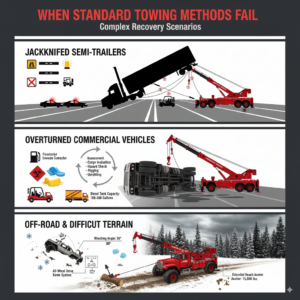
Jackknifed Semi-Trailers
Complex recovery scenarios arise when semi-trailers jackknife at acute angles, often blocking multiple traffic lanes. Standard towing methods fail because conventional equipment lacks the reach, capacity, and positioning flexibility needed.
Multi-point lifting techniques become necessary, using the rotator’s main boom for the tractor while employing winch lines for trailer positioning. This requires coordinated operation of multiple hydraulic systems simultaneously.
Cargo protection during recovery adds another layer of complexity. Operators must secure or transfer cargo before uprighting operations to prevent load shifts that could cause additional damage or create safety hazards.
Overturned Commercial Vehicles
Uprighting procedures carry significant risks and require specialized protocols. The sequence typically involves: scene assessment, cargo evaluation, environmental hazard check, rigging calculation, and controlled uprighting using rotator equipment.
Fuel spill containment protocols activate immediately when commercial vehicles overturn. Diesel tanks hold 100-300 gallons, requiring absorbent materials, containment barriers, and environmental cleanup procedures.
Environmental compliance issues can add substantial costs and delays. Spilled fuel, hydraulic fluid, or cargo materials may require hazmat response teams and specialized cleanup contractors.
Off-Road and Difficult Terrain Recovery
All-terrain recovery vehicles become essential when commercial vehicles leave paved surfaces. These specialized units feature all-wheel drive, extended reach booms, and enhanced ground clearance for challenging recovery situations.
Winching from unstable positions requires careful anchor point selection and load calculation. Operators may need to establish remote anchor points using ground anchors, deadman systems, or other stable vehicles.
Weather-related complications multiply recovery challenges. Snow, ice, mud, or flooding conditions require additional equipment, longer recovery times, and enhanced safety protocols.
Cost Factors in Heavy-Duty Towing
Equipment and Labor Costs
Hourly rates for heavy-duty towing typically range from $200-500 per hour, compared to $75-150 for standard towing. The rate reflects specialized equipment costs, operator expertise, and insurance requirements.
Flat-fee structures may apply for specific services like rotator recovery ($1,500-5,000+) or long-distance heavy hauling ($3-8 per mile). These fees depend on vehicle size, recovery complexity, and regional market rates.
Multi-truck operation expenses occur when recovery requires multiple specialized vehicles. Complex accidents may need a rotator, heavy-duty wrecker, and lowboy trailer simultaneously, multiplying hourly costs.
Specialized operator premium rates reflect the advanced training and certification required for heavy-duty operations. Certified rotator operators command 25-50% higher wages than standard tow truck operators.
Distance and Time Considerations
Local vs. long-distance heavy-duty towing creates different pricing structures. Local operations (under 50 miles) typically use hourly billing, while long-distance transport uses per-mile rates plus equipment positioning charges.
Highway vs. city operation differences affect costs significantly. Highway recoveries often require traffic control, permit fees, and escort vehicles, adding $500-2,000 to base towing costs.
After-hours and emergency surcharges apply to most commercial towing situations. Weekend, holiday, and overnight operations typically carry 25-50% surcharges on standard rates.
Hidden Costs in Commercial Towing
Permit and escort expenses for oversized loads can add $200-800 per transport. Each state requires separate permits, and escort vehicle costs run $150-300 per vehicle per day.
Environmental cleanup responsibilities may fall to the vehicle owner when spills occur during recovery. Costs range from $2,000-20,000+ depending on spill size and environmental impact.
Cargo transfer and storage fees apply when damaged vehicles cannot safely transport their original loads. Transfer costs run $100-300 per hour, while secure storage fees range from $25-75 per day.
Fleet Management and Prevention Strategies

Preventive Maintenance Programs
Regular inspection schedules reduce breakdown incidents significantly. DOT data suggests that systematic preventive maintenance reduces roadside failures by 40-60% compared to reactive maintenance approaches.
Tire and brake system monitoring prevents the most common commercial vehicle breakdowns. Tire pressure monitoring systems and brake temperature sensors provide early warning of developing problems.
Fluid level management systems track engine oil, coolant, hydraulic fluid, and DEF levels continuously. Automated alerts help drivers address issues before they cause roadside breakdowns.
Driver Training and Protocols
Emergency breakdown procedures should be standardized across your fleet. Drivers need clear steps for positioning disabled vehicles safely, deploying warning devices, and communicating with dispatch and emergency services.
Communication with dispatch must include specific vehicle information, exact location details, nature of the problem, and current safety status. This information helps dispatch select appropriate heavy-duty towing resources immediately.
Roadside safety best practices include positioning warning triangles 100-500 feet behind the disabled vehicle, wearing high-visibility clothing, and staying away from traffic lanes whenever possible.
Building Relationships with Heavy-Duty Towing Companies
Pre-negotiated service agreements lock in rates and ensure priority service when emergencies occur. These agreements typically provide 10-25% discounts on standard rates while guaranteeing response times.
24/7 availability requirements mean your heavy-duty towing partner must maintain rotator and heavy-duty wrecker availability around the clock. Verify their backup equipment and mutual aid agreements with other operators.
Multi-location service coverage becomes critical for long-haul operations. Your towing partner should provide or coordinate services across your operating territory through vetted subcontractors.
Regional Considerations and Local Expertise
Interstate Commerce Regulations
Cross-state towing permit requirements vary significantly between jurisdictions. Some states require commercial towing permits, while others rely on standard commercial vehicle authorities.
DOT inspection and compliance requirements may apply during recovery operations. Vehicles being towed may still need to pass DOT inspections before crossing state lines or resuming commercial service.
Hours of service impact on recovery creates complications when drivers approach their legal driving limits during breakdown situations. Recovery timing must consider both driver availability and legal requirements.
Local Heavy-Duty Towing Networks
Regional operator specializations develop based on local conditions and common vehicle types. Mountain regions focus on steep-grade recovery equipment, while agricultural areas emphasize farm equipment capabilities.
Mountain pass and bridge limitations affect routing decisions during heavy-duty transport. Operators must know weight restrictions, height limitations, and seasonal closures for their service territories.
Weather-specific equipment needs vary by region. Northern operators maintain tire chains, auxiliary heating systems, and cold-weather hydraulic fluids, while desert operators focus on heat-related equipment modifications.
Making the Right Choice for Heavy-Duty Situations
Quick Assessment Checklist
Vehicle weight and classification: Determine your vehicle’s GVWR and classification (Class 7-8 requires rotator capability). Check your registration or door placard for exact specifications.
Damage assessment and recovery complexity: Evaluate whether the vehicle is upright, accessible by road, and structurally intact. Complex scenarios require specialized equipment and operator expertise.
Environmental and safety factors: Consider traffic conditions, weather, terrain, and potential hazardous materials. These factors determine required safety protocols and equipment specifications.
Questions to Ask Heavy-Duty Towing Companies
Equipment specifications and availability: “Do you have rotator trucks available 24/7?” “What’s your maximum lifting capacity?” “Do you maintain backup equipment?”
Operator certifications and experience: “Are your operators certified for rotator operation?” “How many years of heavy-duty towing experience do your crews have?” “Do you maintain OSHA compliance certifications?”
Insurance coverage and liability limits: “What are your liability coverage limits?” “Does your insurance cover cargo damage during recovery?” “Are you bonded for commercial towing operations?”
Verify your towing company’s rotator capacity before signing any service agreements. A company claiming heavy-duty capabilities without proper equipment cannot handle Class 8 vehicle emergencies safely.
Conclusion & Expert Recommendations
Final Answer: What Makes Heavy-Duty Towing Different?
Heavy-duty truck towing operates in an entirely different realm from standard automotive towing due to three critical factors:
Specialized equipment, training, and protocols separate heavy-duty operations from standard towing. Rotator trucks, Grade 100 chains, and hydraulic systems operating at 3,000+ PSI create capabilities unmatched by standard equipment.
Regulatory compliance and safety requirements add layers of complexity unknown in light-duty towing. DOT regulations, environmental protocols, and interstate commerce rules govern every aspect of commercial vehicle recovery.
Cost and complexity factors unique to commercial vehicles create financial exposure far exceeding standard towing scenarios. Equipment costs, operator expertise, and regulatory compliance combine to create premium pricing structures justified by the specialized nature of heavy-duty recovery.
Protecting Your Commercial Investment
Establish relationships before emergencies occur. Pre-negotiated agreements with certified heavy-duty towing companies provide priority service, locked-in rates, and confidence in your recovery capabilities.
Understand your vehicle’s specific requirements by knowing its weight classification, dimensional specifications, and any special handling needs. This knowledge helps you select appropriate towing services and avoid costly mistakes.
Invest in prevention and proper maintenance to reduce breakdown incidents. Systematic preventive maintenance programs reduce roadside failures by up to 60% while extending vehicle life and reducing operating costs.
The difference between heavy-duty truck towing and standard automotive recovery isn’t just a matter of scale – it’s a completely different discipline requiring specialized knowledge, equipment, and expertise. Understanding these differences empowers you to make informed decisions that protect your equipment, ensure compliance, and minimize costs when commercial towing situations arise.
Your commercial vehicles represent significant investments requiring specialized care when recovery becomes necessary. Choose your heavy-duty towing partners with the same care you use when selecting mechanics, insurance providers, or other critical business services. The relationship you build today may save your business thousands of dollars and prevent dangerous situations when emergencies occur.
